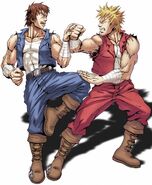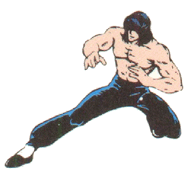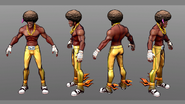Lee Jun-fan (Chinese: 李振藩; November 27, 1940 – July 20, 1973), known professionally as Bruce Lee (Chinese: 李小龍) and often nicknamed the "Little Dragon", was a Hong Kong-American actor, director, martial artist, martial arts instructor and philosopher. He was the founder of the hybrid martial arts Jeet Kune Do. He is considered by commentators, critics, media, and other martial artists to be one of the most influential martial artists and a pop culture icon of the 20th century. He is often credited with helping to change the way Asians were presented in American films.
Lee was born in the Chinatown area of San Francisco, California, on November 27, 1940, to parents from Hong Kong, and was raised with his family in Kowloon, Hong Kong. He was introduced to the film industry by his father and appeared in several films as a child actor. Lee moved to the United States at the age of 18 to receive his higher education at the University of Washington in Seattle, and it was during this time that he began teaching martial arts. His Hong Kong and Hollywood-produced films elevated the traditional Hong Kong martial arts film to a new level of popularity and acclaim, sparking a surge of interest in Chinese martial arts in the West in the 1970s. The direction and tone of his films dramatically changed and influenced martial arts and martial arts films in the US, Hong Kong, and the rest of the world.
He is noted for his roles in five feature-length films: The Big Boss (1971), Fist of Fury (1972), Way of the Dragon (1972), Enter the Dragon (1973) and The Game of Death (1978). Lee became an iconic figure known throughout the world, particularly among the Chinese, based upon his portrayal of Chinese nationalism in his films and among Asian Americans for defying stereotypes associated with the emasculated Asian male. He trained in the art of Wing Chun and later combined his other influences from various sources into the spirit of his personal martial arts philosophy, which he dubbed Jeet Kune Do ("The Way of the Intercepting Fist"). He died in Hong Kong on July 20, 1973 at the age of 32 and was buried in Seattle.
Acting career[]
Lee's father Lee Hoi-chuen was a famous Cantonese opera star. Because of this, Lee was introduced into films at a very young age and appeared in several films as a child. Lee had his first role as a baby who was carried onto the stage in the film Golden Gate Girl. By the time he was 18, he had appeared in twenty films.
While in the United States from 1959 to 1964, Lee abandoned thoughts of a film career in favor of pursuing martial arts. However, a martial arts exhibition on Long Beach in 1964 eventually led to the invitation by William Dozier for an audition. Lee was invited for the role of the sidekick Kato alongside the title character played by Van Williams in the TV series titled The Green Hornet. The show lasted only one season of 26 episodes, from September 1966 to March 1967. Lee and Williams also appeared as their respective characters in three crossover episodes of Batman, another William Dozier-produced television series.
Hong Kong films and stardom[]
Not happy with his supporting roles in the US, Lee returned to Hong Kong. Unaware that The Green Hornet had been played to success in Hong Kong and was unofficially referred to as "The Kato Show", he was surprised to be recognized on the street as the star of the show. Lee signed a film contract to star in two films produced by Golden Harvest.
Lee played his first leading role in The Big Boss (1971), which proved to be an enormous box office success across Asia and catapulted him to stardom. He soon followed up with Fist of Fury (1972), which broke the box office records set previously by The Big Boss. For his third film, Way of the Dragon (1972), he was given complete control of the film's production. In 1964, at a demonstration in Long Beach, California, Lee had met karate champion Chuck Norris. In Way of the Dragon, Lee introduced Norris to moviegoers as his opponent in the final death fight at the Colosseum in Rome, today considered one of Lee's most legendary fight scenes and one of the most memorable fight scenes in martial arts film history.
From August to October 1972, Lee began work on his fourth Golden Harvest film, Game of Death. He began filming some scenes, including his fight sequence with 7 ft 2 in (218 cm) American basketball star Kareem Abdul-Jabbar, a former student. Production stopped in November 1972 when Warner Brothers offered Lee the opportunity to star in Enter the Dragon However, only a few months after the completion of Enter the Dragon, and six days before its July 26, 1973 release, Lee died. Enter the Dragon would go on to become one of the year's highest-grossing films and cement Lee as a martial arts legend.
Lee had shot over 100 minutes of footage, including out-takes, for Game of Death before shooting was stopped to allow him to work on Enter the Dragon. In addition to Abdul-Jabbar, George Lazenby, Hapkido master Ji Han-Jae, and another of Lee's students, Dan Inosanto, were also to appear in the film, which was to culminate in Lee's character, Hai Tien (clad in the now-famous yellow track suit) taking on a series of different challengers on each floor as they make their way through a five-level pagoda. In a controversial move, Robert Clouse finished the film using a lookalike and archive footage of Lee from his other films with a new storyline and cast, which was released in 1978. However, the cobbled-together film contained only fifteen minutes of actual footage of Lee while the rest had a Lee look-alike, Kim Tai Chung, and Yuen Biao as stunt double.
Death[]
On May 10, 1973, Lee collapsed during an automated dialogue replacement session for Enter the Dragon at Golden Harvest in Hong Kong. Suffering from seizures and headaches, he was immediately rushed to Hong Kong Baptist Hospital, where doctors diagnosed cerebral edema. They were able to reduce the swelling through the administration of mannitol. The headache and cerebral edema that occurred in his first collapse were later repeated on the day of his death.
On July 20, 1973, Lee was in Hong Kong to have dinner with actor George Lazenby, with whom he intended to make a film. According to Lee's wife Linda, Lee met producer Raymond Chow at 2 p.m. at home to discuss the making of the film Game of Death. They worked until 4 p.m. and then drove together to the home of Lee's colleague Betty Ting Pei, a Taiwanese actress. The three went over the script at Ting's home, and then Chow left to attend a dinner meeting.
Later, Lee complained of a headache and Ting gave him the painkiller Equagesic, which contained both aspirin and the tranquilizer meprobamate. Around 7:30 p.m., he went to lie down for a nap. When Lee did not come for dinner, Chow came to the apartment, but he was unable to wake him up. A doctor was summoned and spent ten minutes attempting to revive Lee before sending him by ambulance to Queen Elizabeth Hospital. Lee was declared dead on arrival, at the age of 32.
There was no visible external injury; however, according to autopsy reports, Lee's brain had swollen considerably, from 1,400 to 1,575 grams (a 13% increase). The autopsy found Equagesic in his system. On October 15, 2005, Chow stated in an interview that Lee died from an allergic reaction to the tranquilizer meprobamate, the main ingredient in Equagesic, which Chow described as an ingredient commonly used in painkillers. When the doctors announced Lee's death, it was officially ruled a "death by misadventure".
Lee's wife Linda returned to her hometown of Seattle and had Lee's body buried in Lot 276 of Lake View Cemetery in Seattle. Pallbearers at Lee's funeral on July 25, 1973, included Taky Kimura, Steve McQueen, James Coburn, Chuck Norris, George Lazenby, Dan Inosanto, Peter Chin, and Lee's brother Robert. Around the time of Lee's death, numerous rumors appeared in the media. Lee's iconic status and untimely death fed many wild rumors and theories. These included murder involving the triads and a supposed curse on him and his family.
Influence of Bruce Lee in the Double Dragon series[]
The lifetime works and iconic persona of Bruce Lee were of great influence in the creation of the Double Dragon franchise.
Wanting to export titles from the Kunio-kun series to other countries, but aware that they would require heavy localization (as evidenced by their previous title, Renegade), Technōs Japan gave the series' creator Yoshihisa Kishimoto the task of creating a new fighting series that shared a similar gameplay style but that at the same time appealed to Western audiences from its inception. Inspired by pop culture elements of the era, such as the 1979 street gangs-themed film The Warriors and 1981's Mad Max 2, the first Double Dragon game was born as a coin-operated arcade machine in 1987, widely being considered as one of the grandfathers of the beat 'em up genre, as well as one of the most influential (arguably even more than its predecessor Renegade itself).
While the game implemented many Western cultural references, such as its main setting being New York City, as well as emphasizing the idea of dangerous street gangs fighting each other in the city streets, Kishimoto, aware of the sudden resurgence in popularity of classic Eastern martial arts action films in the West, decided to also implement these aspects into the game, being one of the first examples of this particular cultural mixture in entertainment media. Heavily inspired by films starred by legendary martial artist and action films actor Bruce Lee (among other influences), in particular his 1973 film Enter the Dragon, the game implemented the idea of two young martial artists who take on the streets and fight numerous gang members in their quest to rescue a kidnapped girl.
For starters, the two main protagonists of the game were called Billy and Jimmy Lee, with their surname being directly borrowed from Bruce. These two young men were masters of a legendary Chinese martial art known as Sou-Setsu-Ken, which was an amalgamation of various other martial arts; this fighting style is a direct reference to Jeet Kune Do, a hybrid philosophy of martial arts heavily influenced by the personal philosophy and experiences of Bruce Lee, founder of the system. Bruce was also nicknamed the "Little Dragon" in promotional media, which served as inspiration to name the game, "Double Dragon".
Many of the performable fighting moves present in Double Dragon (along with many others that were eventually added as the series progressed) are direct references to iconic moves performed by Bruce Lee in his films and which apparently until then had never been portrayed in martial arts cinema (although it's worth noting that most of these moves had already been introduced in Renegade). Some examples include:
- The iconic throw-opponent-over-the-shoulder move is widely seen in many of Bruce's films, with The Big Boss (1971) being the first time it was ever used. In it, the hero Cheng Chao-an, played by Bruce, uses a variant of the move by throwing the main antagonist, Hsiao Mi, over his head with one arm. The move was also used in Fist of Fury (1972). In it, the hero Chen Zhen (Bruce) irrupts into a rival karate dojo and uses it on at least two of his opponents. The move was also seen when Chuck Norris performs it on Bruce in Way of the Dragon (1972).
- A move introduced in the NES version of Double Dragon, where the player character pins down an enemy on the floor and starts punching them in the face until it is defeated, resembles a similar scene from The Big Boss, where the hero Cheng (Bruce) pounces over the dead body of the main antagonist, Hsiao Mi, and starts punching him until he collapses from exhaustion.
- In Return of Double Dragon, the ability to deflect an enemy's thrown knife back at them by hitting it in midair is likely a reference to a scene in The Big Boss. In the film, the hero Cheng (Bruce) defeats the main antagonist, Hsiao Mi, by kicking back a knife thrown by the latter, which fatally wounds him. This may not be a coincidence, as the game was planned and directed by Muneki Ebinuma, a declared fan of Bruce's films.
- A similar move to jumping onto fallen enemies and landing on them with a heavy kick, introduced in Double Dragon Advance, appears in Fist of Fury, where Chen (Bruce) stomps on the face of a fallen opponent, presumably killing him.
Several enemies introduced in the first two Double Dragon games were named after characters from Enter the Dragon, these being: Roper, Williams, O'Hara and Bolo. In addition, Linda, an iconic female thug introduced in the first game, was likely named after Linda Lee Cadwell (b. Linda Emery), Bruce Lee's wife.
Chin Taimei, an opponent introduced in the NES port of Double Dragon, appears to be an amalgamation of Bruce Lee and Jackie Chan, another legendary martial arts actor and who made a cameo/extra in the aforementioned film. In the "Mode B" versus game of that port, while fighting against another human player, Chin can make use of nunchaku, a weapon that was widely popularized in the West by Bruce Lee's frequent use of it in his films, the first time being in Fist of Fury. This weapon reappeared in Double Dragon 3: The Rosetta Stone, purchasable from shops to enhance the player's fighting capabilities, and was Billy and Jimmy's default secondary weapon in the NES version of the game. The manual for Super Double Dragon states that it's Billy's favorite weapon. Along with it, other weapons that Bruce used in his films, such as bo sticks and bastons, were eventually introduced along the sequels.
Li Cheng-Long, a Chinese enemy boss appearing in Double Dragon 3: The Rosetta Stone, is directly modeled after Bruce Lee. In contrast to the Lee brothers, who use the anglicized form of Bruce's surname, Li is referred to by his actual Chinese surname.
In Double Dragon Advance (a remake of the first game), Billy's profile data states that Bruce Lee is his "martial arts idol". In the credits of that same game, the developers (mainly Ebinuma) thank Bruce for being an inspiration to their work.
The cover art of the aforementioned game depicts Billy and Jimmy in a fighting pose in the same way as the promotional shot of Bruce Lee and Chuck Norris for the 1972 martial arts film Way of the Dragon.
In Double Dragon Neon, one of Williams's alternate skins is modeled after actor Jim Kelly's portrayal of the character of the same name appearing in Enter the Dragon.
Mr. Jones, a character appearing in the one-on-one fighting game Rage of the Dragons, which is a homage to the Double Dragon series (as Evoga, the developers, couldn't get the rights to the franchise), is an amalgamation of various concepts found in the lifetime works of Bruce Lee. These include:
- He is a martial artist as well as a film actor, same as Lee was in real life.
- His fighting style is Jeet Kune Do, which was founded by Lee.
- His fighting screams are nearly identical to Bruce's iconic "dragon" screams while fighting in his films. His body complexion and movements are very similar as well.
- His yellow jumpsuit resembles a similar one worn by Lee in the 1972 martial arts film Game of Death.
- His sunglasses could be a reference to those worn by basketball legend and martial arts aficionado Kareem Abdul-Jabbar in his role of "Mantis" in the same film, and who in real life was one of Lee's most well known apprentices.
- Both his race and the afro hairstyle he fashions resemble those from actor Jim Kelly in his role of Williams in Enter the Dragon.
Gallery[]
References[]
- ↑ 1.0 1.1 1.2 What a great fighter Bruce Lee did to stay strong and slim? at Stars Changes
External links[]
- Bruce Lee at Wikipedia - Original version of this article.








